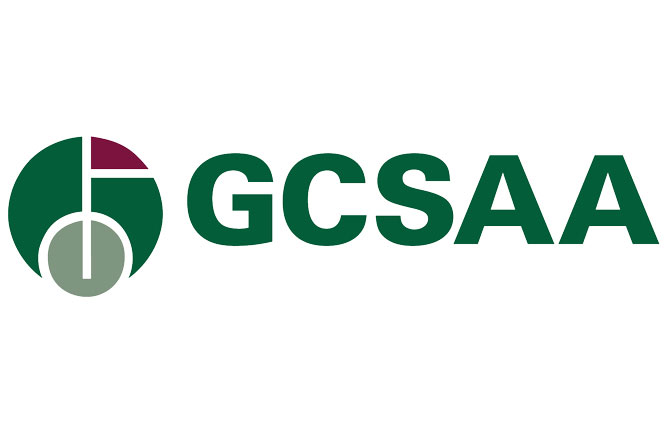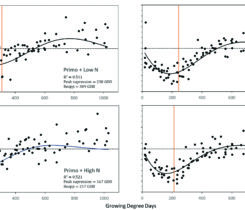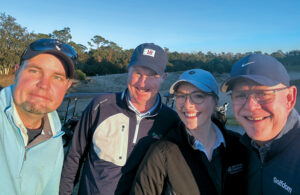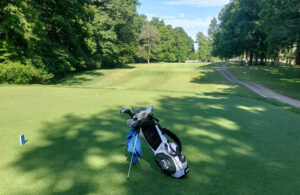Late-fall wetting agent application and ultradwarf bermudagrass winter survival
Winter injury to ultradwarf bermudagrass putting greens can stem from two primary factors: desiccation of plant tissue and exposure to low temperatures. Unlike the effects of low temperatures, tissue desiccation during winter can happen independent of temperature conditions and might be aggravated by soil hydrophobicity.
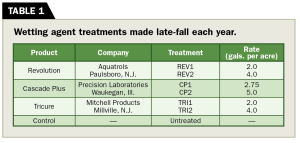 The sandy root zone mixture of a putting green constructed to United States Golf Association (USGA) specifications (13) can make soil hydrophobicity a problem. As hydrophobicity pertains to golf course putting greens, areas that become water-repellent are most commonly found near the upper region of the root zone.
The sandy root zone mixture of a putting green constructed to United States Golf Association (USGA) specifications (13) can make soil hydrophobicity a problem. As hydrophobicity pertains to golf course putting greens, areas that become water-repellent are most commonly found near the upper region of the root zone.
The repellency is most likely a result of individual sand particles becoming coated with an organic compound that displays hydrophobic characteristics. (4,10). Hydrophobic root zones can result in the formation of localized dry spot (LDS), a term used to define “irregularly shaped areas of desiccated, brown turf resulting from soil that has become resistant to wetting from both irrigation and rainfall” (2).
Repellency is a major issue during summer months when evapotranspiration demand is high and when uniform moisture distribution throughout the root zone is necessary for the playability and aesthetic properties of the putting surface.
Wetting agents have gained popularity as a dependable method for alleviating damage attributed to LDS. Wetting agents are chemical surfactants that effectively reduce water surface tension and allow it to penetrate the surface of hydrophobic soil (6). However, the underlying cause of the hydrophobicity may still exist in the root zone.
The beneficial effects of wetting agents may be short-lived and commonly applied to putting greens several times throughout the spring and summer months. Golf course superintendents usually cease wetting agent applications to ultradwarf bermudagrass putting greens as the turf enters dormancy in the late fall.
The underlying cause of soil hydrophobicity could result in turfgrass desiccation caused by soil water repellency, even though symptoms of LDS may not be evident because of the dormant state of the turf.
Although wetting agents reduce soil water repellency on sand-based putting greens (5, 8), research is currently lacking regarding the effect of a late-season wetting agent application on dormant ultradwarf bermudagrass putting green turf to combat winter turfgrass desiccation.
This research aimed to examine the effect of late-fall application of three commercially available wetting agents and treatment rates on winter injury to ultradwarf bermudagrass, winter soil hydrophobicity and soil moisture content and uniformity.
Site Management and Treatments
We conducted a three-year field experiment on a putting green with a sand-based root zone established with mature TifEagle ultradwarf bermudagrass at the University of Arkansas Agricultural Research and Extension Center in Fayetteville, Ark.
We mowed six days per week at a 0.125-inch height of cut (HOC) during the growing season. We groomed the greens three days per week at a 0.110-inch bench setting. Approximately one month before winter dormancy, we raised the HOC to 0.140 inches.
We applied nitrogen every two weeks (0.05 lbs. N per 1000 sq. ft.) from May to September, alternating between 18-9-18 and 46-0-0 spray-grade urea applications. According to annual soil testing recommendations, we applied phosphorous, potassium and micronutrients (3).
We withheld irrigation during winter but did irrigate in the growing season to replace 100 percent of reference evapotranspiration. Our team applied sand topdressing applications at a 0.05-inch depth at two-week intervals during the growing season. We also performed core aerification annually with 0.5-inch tines and a 2-by-2-inch spacing.
Our team applied the plant growth regulator trinexapac-ethyl (Primo, Syngenta, Basel, CH) monthly at 0.05 gallons per acre during the growing season. During the winter, we placed a black permeable polypropylene protective cover (Xton Inc.) on the green when forecasted temperatures dropped below 25 degrees F. We removed the cover for favorable weather, similar to a golf course, to allow for play on warmer winter days.
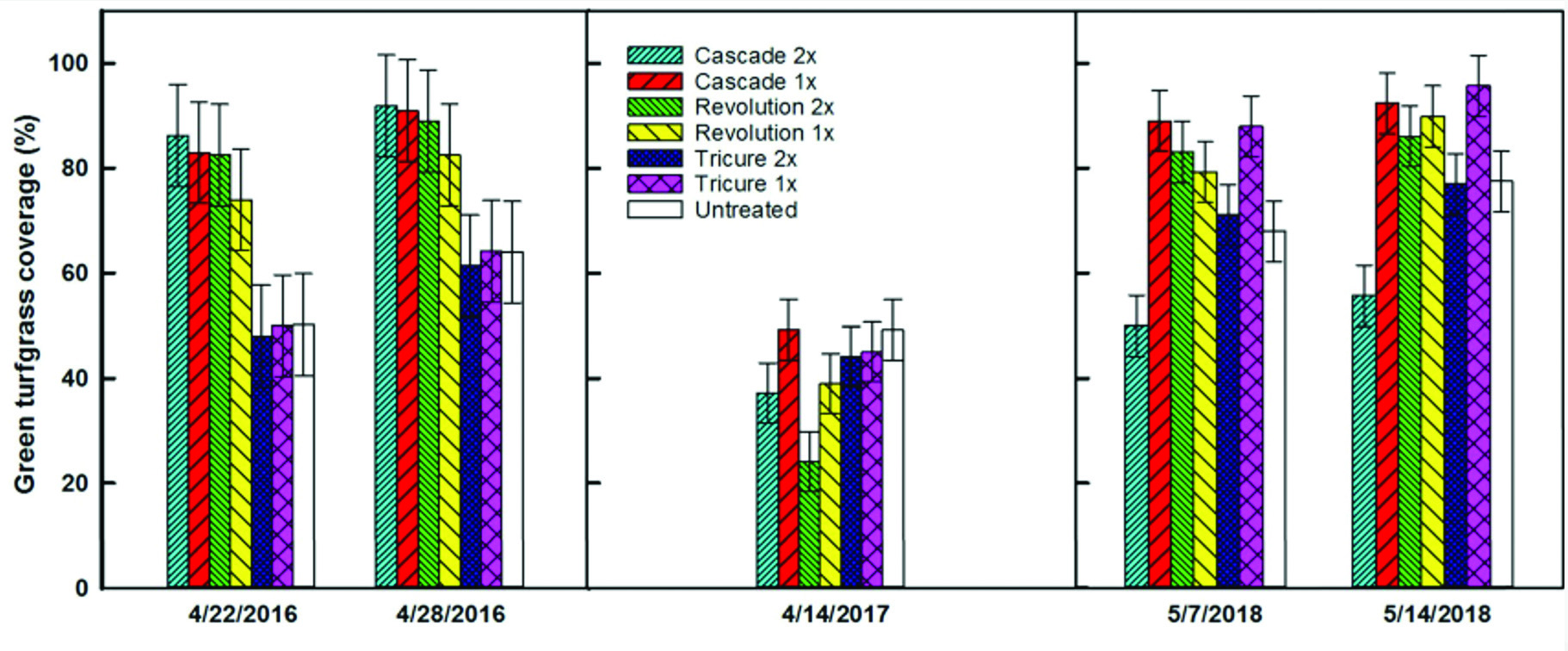
(Fig. 1) Effect of late-fall wetting agent applications on the green turfgrass coverage of an ultradwarf bermudagrass putting green in Fayetteville, Ark., from 2016–2018.
The three wetting agents used for this study included Revolution, Cascade Plus and Tricure. We applied each wetting agent at either the label or two times the label rate to determine if there was any benefit from more prolonged residual efficacy with higher application rates (Table 1).
We made wetting agent applications with a three-nozzle, CO2-pressurized plot sprayer with flat fan nozzles (8005VS; TeeJet), delivering 75 gallons per acre of spray volume. Our team applied wetting agent applications on Dec. 14, 2015, Dec. 8, 2016 and Dec. 7, 2017, followed by 0.25 inches of irrigation to the entire experiment to move products into the root zone. We withheld irrigation after that until the end of the trial each year.
Data Collection and Experimental Design
We evaluated volumetric water content (VWC) monthly by taking nine random measurements per plot during the initial trial winter and 12 random measurements per plot twice monthly during the final two winters with a Field Scout TDR 300 Soil Moisture Meter equipped with 1 ½ inch-long rods.
Our team evaluated green turfgrass coverage by digital image analysis (12) during the spring green-up period of each season. We took one picture per plot weekly from February to May during the spring of 2016. In the spring of 2017 and 2018, we took three photos per plot weekly from February to May to account for the larger plot dimensions in these years.
We evaluated root zone water repellency twice each trial season with a water drop penetration time (WDPT) test on soil samples collected two weeks after the wetting agent application and again on samples collected on March 22, 2016, March 27, 2017 and March 26, 2018.
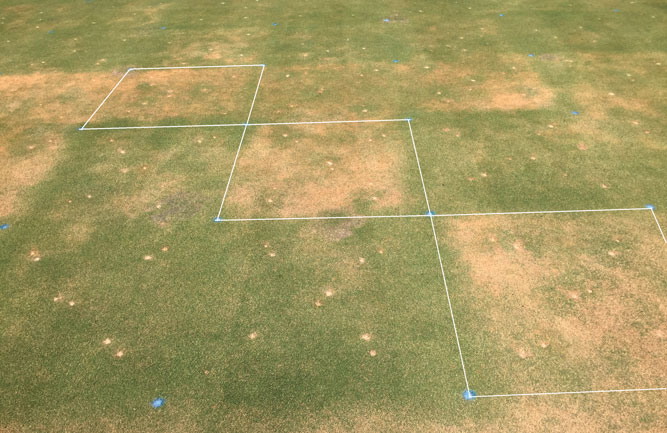
(Fig. 2) Delayed spring green-up of ultradwarf bermudagrass in untreated control plots in Fayetteville, Ark., in April 2016. (Photo: Mike Richardson, Ph.D.)
We collected samples consisting of five intact soil cores, 3 inches long and 1 inch in diameter from each plot, air-dried them for two weeks and tested them for water repellency via the WDPT test (7, 9). We performed the WDPT test by placing a droplet of deionized water on the cores at depths of 1, 2, 3, 4 and 5 centimeters (measured from the top of the soil core) and recording the time in seconds for the droplet to penetrate the surface of the soil core. We recorded any water droplets remaining after 10 minutes as 600 seconds.
We analyzed all data separately each year because of inconsistencies in the evaluation dates and intervals among the three trial periods. Our team analyzed data for the percentage of green cover and soil volumetric water content through repeated measures ANOVA as an augmented factorial (11) randomized complete block design. We added sampling depth as an additional factor in the WDPT data analysis. We also separated treatment means for significant effects via Fisher’s protected LSD (α = .05).
Comparing Wetting Agent Effects on Green Turfgrass Coverage
In each year, a late-fall wetting agent showed the occasional ability to increase green turfgrass coverage (Figure 1 and Figure 2). In 2016 and 2018, multiple treatments increased green turfgrass coverage compared to untreated control on multiple dates. No product or rate consistently increased or decreased green turfgrass coverage yearly, reinforcing the highly variable nature of LDS formation and the effects of wetting agents on green turfgrass coverage the following spring.
On April 14, 2017, no treatment increased green turfgrass coverage compared with the untreated control (Figure 2). The lack of any effect in 2017 may be due to a dramatic increase in precipitation, most notably in April 2017 (Table 2).
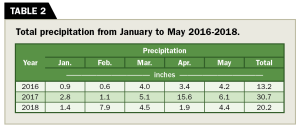 Comparing Wetting Agent Effects on Soil Volumetric Water Content
Comparing Wetting Agent Effects on Soil Volumetric Water Content
We observed no treatment effect for soil volumetric water content in any year (data not shown). Although comparisons across years were not possible, the mean soil volumetric water content pooled across treatments for April 2016 was 13 percent compared with 20 percent in April 2017. This may help explain the lack of a wetting agent effect on green turfgrass coverage in 2017.
Additionally, it may be possible that the inherent variability in daily soil volumetric water content, specifically at the 1.5-centimeter sampling depth, resulted in a lack of differences among the treatments.
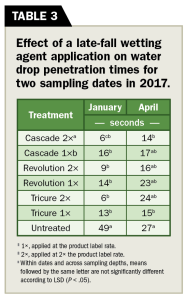 Comparing Wetting Agent Effects on WDPT Tests
Comparing Wetting Agent Effects on WDPT Tests
In general, we only observed water repellency in the top 2 centimeters of the soil profile. In January 2016, at the 1-centimeter soil depth, each treatment, excluding TRI1× and TRI2×, had reduced WDPT compared with the untreated control (Figure 3A). At the 2-centimeter soil depth in January 2016, only REV2× and CP2× had lower WDPT than the untreated control.
In April 2016, at the 1-centimeter soil depth, CP1×, REV2×, and REV1× had lower WDPT than the untreated control (Figure 3B). No treatment differed from the untreated control in April 2016 at the 2-centimeter soil depth. At the 3-, 4-, and 5-centimeter soil depths in 2016, no differences among treatments or between the treatments and the untreated control indicated any practical differences, as the untreated control exhibited minimal water repellency at these depths.
In January 2017, all treatments reduced WDPT compared with the untreated control but were not different from each other (Table 3). Only TRI1× and CP2× had lower WDPT than the untreated control in April 2017, but these treatments were not different from other wetting agent treatments.
Similar to 2017, in January 2018, the treatments did not differ, but all treatments reduced WDPT compared with the untreated control (Table 4). In April 2018, there were no differences among treatments or between the treatments and the untreated control.
When considering depth, in 2018, all treatments reduced WDPT compared with the untreated control at the 1-centimeter soil depth, and all treatments, excluding REV1× and TRI1×, reduced the 2-centimeter soil depth WDPT compared with the untreated control (Table 4).
Though comparisons among years are not possible, some differences between WDPT in 2016 and 2017 are worthy of discussion. We noted increased WDPTs at the 1-centimeter soil depth and for the untreated controls at the 1-centimeter soil depth between 2016 and 2017.
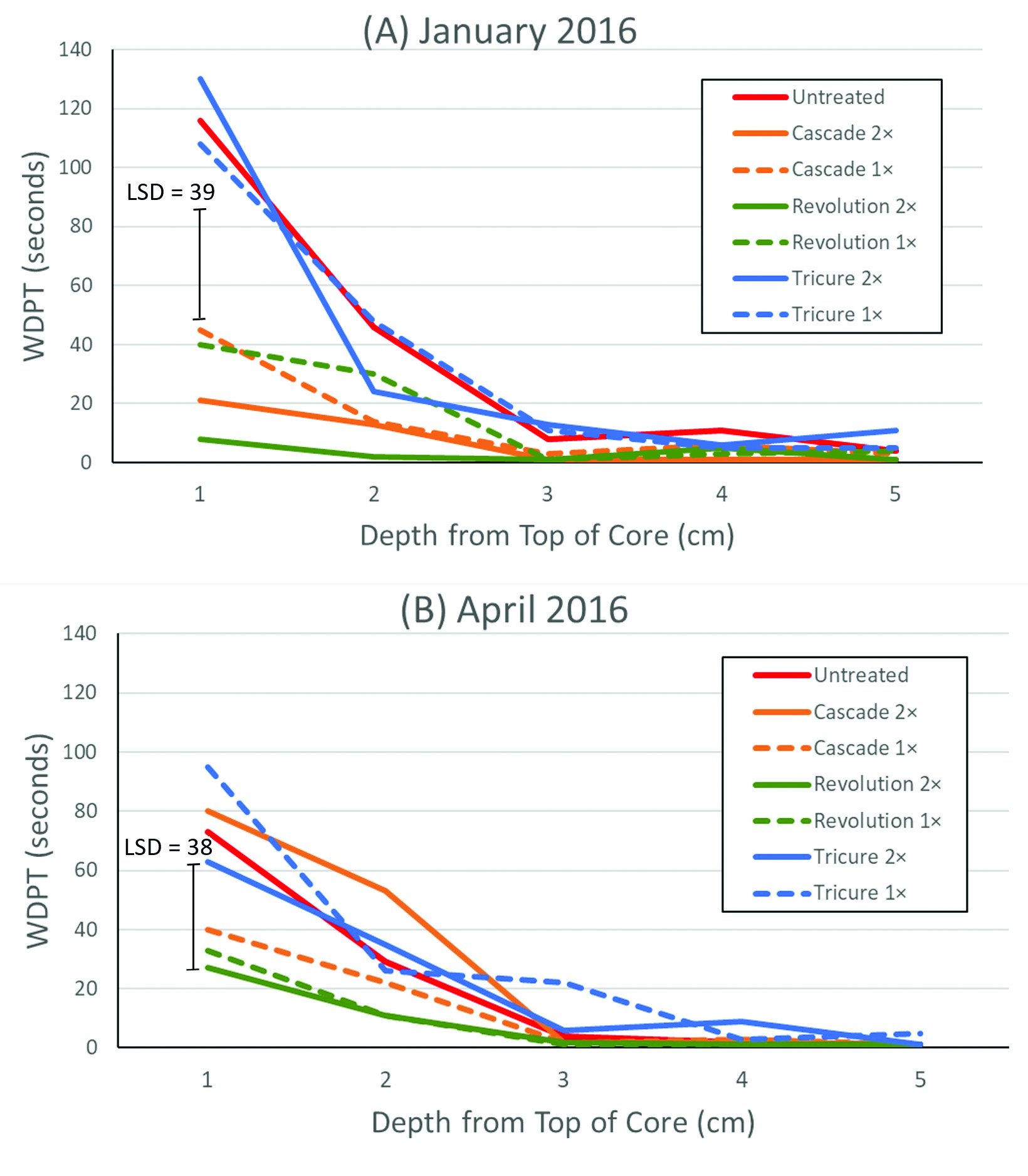
(Fig. 3) Effect of sampling date, soil depth, and late-fall wetting agent application on water drop penetration time tests for two sampling dates in (A) January 2016 and (B) April 2016.
In April 2016 and 2017, the 1-centimeter soil depth pooled across treatments had WDPTs of 62 and 36 s, respectively. The untreated controls at the 1-centimeter soil depth had a WDPT of 94 s compared with 67 s in 2017.
The reduction in hydrophobicity at the 1-centimeter soil depth in 2017 could partially explain the lack of a wetting agent effect on green turfgrass coverage in 2017. Throughout the trial, there appeared to be minimal residual wetting agent effects in the spring following a late-fall application or by increasing the application rate of a late-fall treatment.
Although not always statistically significant, WDPTs were lower in April than in January, suggesting that the changes in soil properties resulting from four months of cooler temperatures and 13 to 31 inches of rainfall (Table 2) may allow for some natural decline in root zone water repellency.
No treatment consistently reduced WDPT in both January and April of each year. In 2016, CP1×, REV1×, and REV2× appeared to have a residual effect at the 1-centimeter soil depth, as WDPTs were reduced compared with the untreated control in April. Revolution has also shown a residual effect the following spring after fall application on a creeping bentgrass putting green in Minnesota (1).
Recommendations for Wetting Agent Application
This research demonstrates that late-fall application of a wetting agent can provide added protection to ultradwarf bermudagrasses from winter injury associated with desiccation. The benefits of late-fall wetting agent application appear to be more pronounced in years with drier winter conditions, suggesting that protection might be even more valuable for a nonirrigated golf course than for a golf course that can irrigate during the winter months.
Research involving targeted soil moisture conditions during the winter is necessary to make a definitive statement.
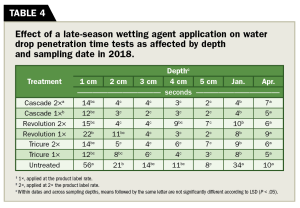 Although wetting agent treatments increased green turfgrass coverage compared with the untreated control on multiple dates, it remains uncertain what may be directly responsible for this effect. One possible cause for increased green turfgrass coverage is the reduced hydrophobicity of the surface soil layer.
Although wetting agent treatments increased green turfgrass coverage compared with the untreated control on multiple dates, it remains uncertain what may be directly responsible for this effect. One possible cause for increased green turfgrass coverage is the reduced hydrophobicity of the surface soil layer.
There was no evidence that soil volumetric water content in the upper 1.5 inches contributed to enhanced green coverage.
Despite this, the authors speculate that greater sampling frequency and/or depth may have altered the results. Although wetting agents did not affect soil volumetric water content, wetting agents did reduce WDPT in the top 2 centimeters of the soil profile, and, in one season, that benefit persisted in the top 1 centimeter of the soil profile.
Throughout the trial, the 2× application rate never increased green turf coverage compared with the 1× rate of the same product, suggesting that for a one-time late-fall application, the 1× rate would be sufficient as an insurance policy if dry weather persisted throughout the winter months.
Further research in this area looking into the effects of repeated wetting agent applications to a dormant ultradwarf bermudagrass putting green throughout the winter months may assist golf course superintendents in decision-making for minimizing winter injury of bermudagrass putting greens. In addition, it would be beneficial to understand the effects of irrigation or rainfall frequency on the efficacy of wetting agents during the dormant season.









